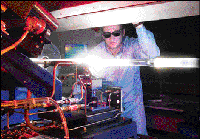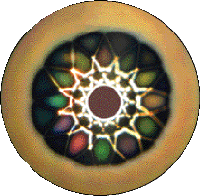Paula M. Powell, Senior Editor
The competition between fiber and disk lasers seems to be heating up with the fibers' quest for a share of the industrial welding and cutting market. A group of researchers from Southampton Photonics Inc. and the University of Southampton's Optoelectronics Research Centre, both in the UK, recently demonstrated 1 kW of output through a single fiber, with beam quality close to M2 = 3. Nearly 80 percent of the pump power launched into the fiber was converted to output power at 1090 nm. In June, the team had reported 600 W of output with M2 = 1.26.

The specialty fiber manufacturing process begins with the glass preform being heated by an oxy/hydrogen burner, causing a glass layer to form on the inside of the tube. The required refractive index profile is built up from numerous passes by altering dopants and ratios as required. The inset is a cross section of structured high-numerical-aperture fiber.
A fiber laser has as its lasing medium an optical fiber, most often doped with ytterbium, which amplifies light when pumped by a laser diode (single emitter). The kilowatt output generated by Southampton is a record for a single laser, although IPG Photonics in Oxford, Mass., has bundled together the output ends of lower-power lasers to create a system capable of multikilowatts.
With bundled fiber laser technology, Woods reported, the output beam can have an M2 value in the range of 22 to 50. This is quite good when one considers that 4-kW Nd:YAG lasers found in automotive welding applications probably offer M2 = 80. Currently, a typical working distance for an automotive application is around 200 mm. Woods said that his firm's goal is to get to a 1-kW single-fiber laser with M2 = 1. With that larger building block, a 4-kW fiber laser machining system could offer M2 of less than 10, which could translate to a working distance of 400 to 500 mm.
As a result, the area that the laser can cover without robot movement would increase significantly. Southampton engineers also believe that a larger working distance would allow tremendous savings in optics needed to protect the laser.
Single-mode fiber lasers show promise in applications such as micromachining. In cooperation with Ken Watkins and the laser group at the University of Liverpool in the UK, Klaus Kleine and his colleagues with medical device manufacturer Guidant Corp. in Santa Clara, Calif., have explored fiber laser technology from a variety of vendors, such as Southampton Photonics, IPG and JDS Uniphase, in applications ranging from microcutting of medical stents to microwelding of other medical components.

What's important to note with the Southampton announcement is the high beam quality and high power output through one fiber. Although this demonstration took place in the laboratory, according to Stuart Woods, director of business development, it signals Southampton Photonics' intent to be a player in the multikilowatt fiber laser market.
A stent is a cylindrical metal scaffolding designed to restore blood flow when inserted into a diseased coronary artery. Work material is most commonly stainless steel; however, devices also have been built of nickel titanium and other super alloys and polymers. According to Kleine, the key to successful laser processing is the ability to produce a small, repeatable kerf width, which demands reliable beam quality and laser power stability.
In one set of experiments, researchers worked with a computer numerical control motion system, a 50-W IPG fiber laser (M2 = 1.1), a beam collimator and a cutting head, including a focusing optic and an assist gas nozzle. They collimated the beam to a 5-mm diameter and then focused it with a 50-mm optic. Kleine reported that they were able to reach kerf widths of 0.018 to 0.020 mm in 0.1-mm-thick samples of 316L stainless steel.
The team concluded that cuts that are made with the fiber laser have features similar to those produced by other laser types. In addition, it is possible to optimize surface quality and thickness of the recast layer by tweaking parameters such as pulse length and assist gas pressure. Lower peak pulse power, for example, translates to less pronounced striation and improved surface roughness. Higher pulse-to-pulse overlap also is beneficial.
The Guidant laser group has so far had good results with stents, and it is exploring other application areas for fiber lasers. No technology is perfect, though, and Kleine would like to see better user interfaces.
Woods believes that cost is becoming less of an issue for fiber technology, compared with conventional diode-pumped solid-state systems. Although available pulse power may still be a limiting factor, he predicted that end users will see comparable pulse power capability within months.
Will fiber technology completely replace industrial Nd:YAG systems? Probably not, Woods said, but he expects the competition with disk lasers to be another story altogether.